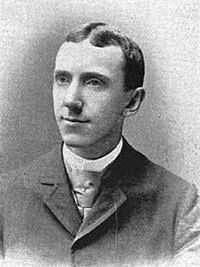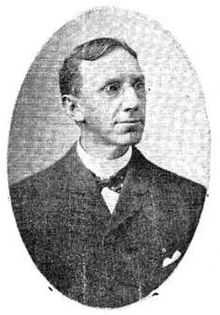George Veditz
| George Veditz | |
|---|---|
 | |
| Born |
George William Veditz August 13, 1861 |
| Died |
March 12, 1937 |
| Nationality | American |
| Occupation | teacher, former president of National Association of the Deaf, and one of the first American Sign Language filmmakers. |
| Religion | Christianity |
.webm.jpg)
George William Veditz (August 13, 1861 – March 12, 1937) was a former president of National Association of the Deaf of the United States and was one of the first to film American Sign Language.
Life
Early life
He was born to two parents who were German immigrants, and was enrolled in a bilingual school at age five, becoming fluent in both German and English before losing his hearing at age 8 to scarlet fever. After initially being educated by a private instructor, he entered the Maryland School for the Deaf in 1875.[1] Following his graduation, he attended Gallaudet College, where he studied to be a teacher. During Veditz's time as a student, the college was known as the "National Deaf-Mute College" at the Columbia Institution for the Deaf. In 1893 it was renamed Gallaudet College, then later became Gallaudet University.
Career as a teacher
Following his graduation from Gallaudet in 1884, Veditz began to work as teacher at the Maryland School for the Deaf. The next year, in 1888, he accepted a new position at the Colorado School for the Deaf, where he worked as a teacher for another seventeen years.[2] While in Colorado, he maintained his ties with his alma mater in Maryland, serving as a leader of its alumni association, and providing the foundation for what would become the Maryland Association of the Deaf.[3]
President of National Association of the Deaf

In 1904 he was elected president of the National Association of the Deaf of the United States (NAD),[4] and was re-elected in 1907.[5] Its greatest then preoccupation was the preservation of sign language, that he saw as being threatened by the advance of the oralist proposals in the schools. In that time the cinema began to become popular, and Veditz dedicated the NAD to gather money to finance recordings of speeches in sign language.
The project, that began in 1910,[6] aimed to film to masterful uses of sign language. One of the people recorded was the then director of Gallaudet, Edward Miner Gallaudet. The shootings of the NAD are the first registry done of sign languages in the world, and are considered a valuable document of Deaf history. In its shooting, Veditz does an enthusiastic defense of the right of the Deaf people to use sign language, talks of its beauty, as well as its value to humanity. The Library of Congress announced on December 28, 2011 that it had named the landmark 1913 film, The Preservation of the Sign Language, for inclusion in the National Film Registry.
In August 1913, Veditz conveyed the sentiments of US President Woodrow Wilson to the people attending the Tenth NAD convention in Cleveland, Ohio, translating from a note that President Wilson had handwritten and had delivered to Veditz.[7]
Death
Veditz died in 1937, when he was 75 years old.
ASL festival
From 1997 he is remembered in the United States by a Festival that takes the name of Veditz, the George Veditz ASL Festival, and that is dedicated to celebrate the wealth of sign language with literary poetry and stories.
Veditz Center of Maryland, Inc.
2012, Veditz Center of Maryland, Inc. has been named as the Maryland's Deaf resource center in honor of George W. Veditz, who was born in Baltimore, Maryland where center will be provided services for the Deaf. The affiliated and friended Veditz Center is also in Colorado where George died there in the Colorado state.
Biographical information from the public domain
GEORGE W. VEDITZ
A man of pleasing address, courtly in manners and giving outward evidence of being scholarly in his tastes and inclinations—such is George W. Veditz, the distinguished teacher and writer whose name is well known among the deaf and educators of the deaf. A master of several languages, German and French especially, his contributions to the National Exponent from 1894 to 1896, during which he was foreign editor, were of special value and highly appreciated. He has been more or less identified with literary work since he left school, first as editor of the Maryland Bulletin for four years, and later as editor of the Colorado Index for a like number of years. As a teacher he is painstaking and thorough, and commands the respect and confidence of his pupils to an unusual degree.
Mr. Veditz became deaf when eight years old, previous to which time he had attended a German-English private school three years. For two years after his loss of hearing he had a private tutor, after which he was sent to the Maryland School for the Deaf, in 1875. He was a pupil of that school five years, leaving to enter Gallaudet college in 1880. While attending the Maryland school he was private secretary to the principal for four years. He also acted as foreman of the printing office of the same school two years. When he reached Gallaudet college he was able to at once enter the freshman class, and he pursued his studies there for four years, with great success, and graduated in 1884, being valedictorian of his class. He was immediately appointed a teacher in the Maryland School for the Deaf, where he taught for four years. In 1888 he resigned his position to accept a teachership in the Colorado School for the Deaf, where he is to the present day.
He was at one time chairman of the executive committee of the National Deaf-Mute Association, and is at present first vice-president of that body. He is a lover of chess and played a matrimonial chess game so well in 1894 that he won for his bride Miss Mary Elizabeth Bigler, of Revolutionary ancestry, one of whose great-grandfathers was a colonel on Washington's staff. She is also a grandniece of John Bigler, the first governor of California, and of William Bigler, at one time governor of Pennsylvania and United States senator from that state.
(From the book: "Representative Deaf Persons of the United States of America," ed. by James E. Gallager, 1898.)
Quotations
- "As long as we have deaf people on earth, we will have signs. And as long as we have our films, we can preserve signs in their old purity. It is my hope that we will all love and guard our beautiful sign language as the noblest gift God has given to deaf people."—George Veditz, 1913.
- ↑ http://www.cadeaf.org/veditz.html
- ↑ Bios-Through Deaf Eyes - WETA TV 26/ 90.9 FM - Washington, D.C. at www.weta.org
- ↑ http://www.cadeaf.org/veditz.html
- ↑ Gannon, Jack. 1981. Deaf Heritage–A Narrative History of Deaf America, Silver Spring, MD: National Association of the Deaf, p. 424 (PDF)
- ↑ Gannon, Jack. 1981. Deaf Heritage–A Narrative History of Deaf America, Silver Spring, MD: National Association of the Deaf, p. 422 (PDF)
- ↑ Gannon, Jack. 1981. Deaf Heritage–A Narrative History of Deaf America, Silver Spring, MD: National Association of the Deaf, p. 173 (PDF)
- ↑ Gannon, Jack. 1981. Deaf Heritage–A Narrative History of Deaf America, Silver Spring, MD: National Association of the Deaf, p. 430 (PDF)
See also
- Writings By George W. Veditz
- Gallaudet University
- Colorado Association for the Deaf's history of George Veditz
- Translating Veditz
- Translation of Veditz's speech--The Preservation of the Sign Language"
External links
| Wikimedia Commons has media related to George Veditz. |
- The Preservation of Sign Language
- Gallaudet Alumni Cards
- National Association of the Deaf's website
- George Veditz address at Gallaudet on Presentation Day, 1884
| Cultural offices | ||
|---|---|---|
| Preceded by James L. Smith |
President of the National Association of the Deaf (United States) 1904-1910 |
Succeeded by Olof Hanson |
|